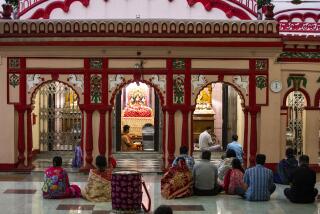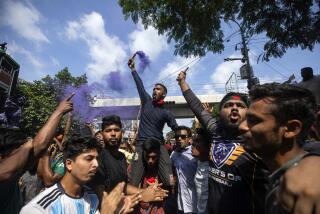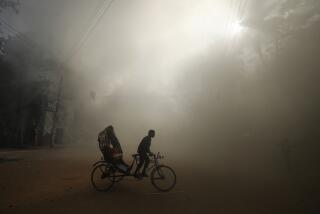Bangladesh Battles Hard to Stay Above Water : Asia: Floods sweep across much of its territory every year. Cyclones bring storm surges. Midstream formations come and go.
Bangladesh is a country that floats. It sits atop one of the world’s largest river deltas, a vast flood plain where the Ganges, Jamuna (Brahmaputra), Padma and Meghna rivers and their myriad tributaries interlace across terrain only a few feet above sea level.
Water completely defines Bangladesh. Every year floods sweep across much of its southern Asian land. Catastrophic tropical cyclones bring storm surges as well as murderous winds.
But the power of the water to destroy is almost equally matched by its power to create, Charles E. Cobb Jr. reports in the National Geographic. “I began to understand this on a char, a sort of pancake of land, in the middle of the Jamuna River.”
Chars change shape continually as the rivers move silt--2 billion tons a year--into the Bay of Bengal. During flood season most chars rise only a little above the water. Almost always they disappear within a decade.
But many people have no choice but to live on these temporary islands. Bangladesh is among the most densely populated countries in the world, with 2,000 people per square mile--a density comparable to putting half the population of the United States into the state of Wisconsin.
At the current growth rate, the population will double in 30 years. Despite the risk, many people prefer chars to the squalid, crowded city slums.
“At least on a char you can own something,” one resident of Manushmara char told Cobb matter-of-factly. Manushmara is only 2,000 feet long and 70 feet wide, but 475 families live there.
Before a char is engulfed, its residents must look for another. Land is the real hunger in Bangladesh. Eighty percent of Bangladesh’s population is rural. Sixty percent is landless. Just 10% of rural households possess more than half of the arable land.
Bangladesh is one of the world’s poorest nations. Per-capita income is $200. Only 30% of men and 19% of women can read. Sixty percent of children are malnourished. Infant mortality is 120 per 1,000 live births.
In Bangladesh any problem inevitably assumes overwhelming proportions, Cobb writes. Of all the natural disasters that hit--floods, drought, earthquakes and tornadoes--cyclones may be the worst.
Bangladesh sits at the head of the Bay of Bengal, directly in the path of some of the world’s most powerful tropical storms. In the last 32 years, 16 cyclones have slammed into Bangladesh. Over the bay, usually during the spring and fall, swirling tropical depressions form, which can sometimes become cyclones right on the nation’s doorstep.
In 1991 a cyclone and accompanying storm surge killed an estimated 139,000 people. It left perhaps 10 million homeless. That was a “super” cyclone, as A. M. Choudhury of the Space Research and Remote Sensing Organization calls it, “equivalent to several thousand atom bombs of megaton strength.”
The islands in the Bay of Bengal bear the brunt of such cyclones. Like chars, these islands are densely populated, but they are more stable.
There are many conflicting views about whether the nation’s complex 10-level cyclone warning system is effective and about how the aftermath of the fury should be managed. But on one point everyone agrees: The difference between life and death in a cyclone is shelter.
In low-lying coastal areas, storm surges, not wind, are the real danger, and the many flimsy huts of mud and grass are no protection from killer water.
About 300 shelters have been built in the coastal region; about 3,000 are needed. As Marcel Fortier of the International Federation of Red Cross and Red Crescent Societies puts it, in Bangladesh “every problem is enormous, but not the resources.” So, little priority has been given to building cyclone shelters.
Flood control, more than shelter building, is what dominates official concern and expenditure. Floods affect the cities, the rich as well as the poor, industry as well as peasant plots. And the floods come each year.
But its flood plains make Bangladesh one of the world’s most fertile nations. Everywhere among the meandering rivers are bountiful fields. Bangladeshis call their land “sonar Bangla,” or golden Bengal, for the gold of ripening paddies.
In many places peasant farmers grow three rice crops a year. In rice, Bangladesh is self-sufficient.
When the rivers swell with monsoon rains and snowmelt from the mountains of India and Nepal, much of the land goes under water. Villagers wait for the water to subside, then plant again.
In 1988 two-thirds of Bangladesh was submerged for six weeks. In the badly hit city of Chandpur, recalls 28-year-old Ahad Ali, danger had been evident for days. Ali and his mother left to look over a possible new home site on higher ground. His little sister stayed behind.
“She released the cows,” he told Cobb, “and she thought that if the cows were saved, she would be saved. So she tried to ride out on one of the cows, neighbors say.” Ali never saw her again.
For all the drama of high waters, it is erosion that takes a daily toll.
Calamity is a part of daily life in Bangladesh, but so is survival. Fatalism is a kind of bulwark.
“So it has been ordained, so it must happen” is a frequent reply among villagers. “Life and death, they take it as the wish of the almighty God,” says Farida Hasan, a member of Parliament.
The government, with the World Bank and other international agencies, has big plans to master the rivers. As the irrigation ministry’s Tauhidul Anwar Khan puts it: “It is time to attack the rivers. We can’t let them do what they like.”
Everyone agrees that flooding is beneficial. Even after the 1988 flood, crop yields were larger than before. But change the rivers? That is risky and could upset the environmental balance.
But Bangladesh abounds in what it needs most: “prottasha,” or hope.
More to Read
Sign up for Essential California
The most important California stories and recommendations in your inbox every morning.
You may occasionally receive promotional content from the Los Angeles Times.










